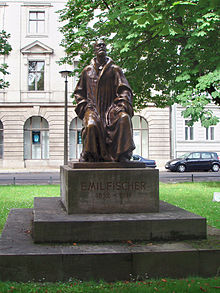Emil Fischer
Hermann Emil Fischer | |
|---|---|
purines | |
| Awards |
|
| Scientific career | |
| Fields | University of Berlin (1892–1919) |
| Doctoral advisor | Adolf von Baeyer |
Hermann Emil Louis Fischer
Early years and career
Fischer was born in
In 1875 von Baeyer was asked to succeed Justus von Liebig at the University of Munich and Fischer went there with him to become an assistant in organic chemistry. In 1878 Fischer qualified as a "Privatdozent" at Munich, where he was appointed associate professor of analytical chemistry in 1879.[7]
In 1882 he was appointed professor of chemistry at the University of Erlangen and in 1885 at the University of Würzburg. In 1892 he succeeded von Hofmann as professor of chemistry at the University of Berlin.[8]
Fischer married Agnes Gerlach in 1888. She died seven years later, leaving him a widower with three sons. The younger two died during their military service in World War I, but the oldest, Hermann, became an organic chemist.[6] Emil Fischer died in Berlin on 15 July 1919 at the age of 66.[5]
Research
He investigated the derivatives of phenylhydriazines, establishing their relation to the
He next turned to the
Fischer is particularly noted for his work on sugars. Among his early discoveries related to hydrazine was that phenylhydrazine reacted with sugars to form substances which he named osazones, and which, being highly crystalline and readily formed, served to identify such carbohydrates more definitely than had been previously possible.[8] Later, among other work, he is noted for the organic synthesis of D-(+)-glucose.[9] He showed how to deduce the formulae of the 16 stereoisomeric glucoses, and prepared several stereoisomerides, helping to confirm the Le Bel–Van 't Hoff rule of the asymmetric carbon atom.[8]
In the field of enzymology, Fischer is known for his proposal of "the lock and key" model as a mechanism of substrate binding.[10]
Fischer was also instrumental in the discovery of
Honours, awards, and legacy

In 1897 he put forward the idea to create the
Many names of chemical reactions and concepts are named after him:
- Fischer indole synthesis
- Fischer projection
- Fischer oxazole synthesis
- Fischer peptide synthesis
- Fischer phenylhydrazine and oxazone reaction
- Fischer–Speier esterification
- Fischer glycosidation
- Kiliani–Fischer synthesis
The Fischer–Tropsch process is named after Franz Emil Fischer, who headed the Max Planck Institute for Coal Research in Muelheim, and is unrelated to Fischer.[19]
References
- ^ a b "Fellows of the Royal Society". London: Royal Society. Archived from the original on 16 March 2015.
- PMID 12458504.
- .
- .
- ^ a b "Emil Fischer - Biographical". The Norbel Prize Organization. Retrieved 31 March 2020.
- ^ ISBN 978-0-684-10114-9.
- ^ Emil Fischer – Biographical. NobelPrize.org. Nobel Prize Outreach AB 2023. https://www.nobelprize.org/prizes/chemistry/1902/fischer/biographical/
- ^ a b c d e One or more of the preceding sentences incorporates text from a publication now in the public domain: Chisholm, Hugh, ed. (1911). "Fischer, Emil". Encyclopædia Britannica. Vol. 10 (11th ed.). Cambridge University Press. p. 426.
- .
- .
- PMID 18568113.
- S2CID 254087824.
- ^ Fischer, Emil (1906) Untersuchungen über aminosäuern, polypeptide und proteine via Internet Archive
- PMID 11621201.
- ^ "Emil Fischer - Facts". The Nobel Prize Organization. Retrieved 30 March 2020.>
- ^ "Emil Fischer". www.nasonline.org. Retrieved 11 December 2023.
- ^ "Emil Fischer". American Academy of Arts & Sciences. 9 February 2023. Retrieved 11 December 2023.
- ^ "APS Member History". search.amphilsoc.org. Retrieved 11 December 2023.
- .
"From My Life", an English translation of "Aus Meinem Leben", Emil Fischer's autobiography. D. M. and E. J. Behrman, Springer Verlag, 2022.
External links
- Emil Fischer on Nobelprize.org including his Nobel Lecture Nobel Lecture, 12 December 1902 Syntheses in the Purine and Sugar Group
- Eminent Chemists of Our Time By Benjamin Harrow pages 216–239, published 1920 by Von Nostrand Company at books.google.com.
- Aders Plimmer, R. H. (July 1907). "The work of Emil Fischer and his school on the chemistry of the proteins". Science Progress in the Twentieth Century. 2 (5): 88–120.
- Guide to the Emil Fischer Papers at The Bancroft Library
- Text-book of Physiological Chemistry in Thirty Lectures by Emil Abderhalden, translated by William Thomas Hall and George Defren; published 1908 by Wiley Company, has many technical references to Fischer's work in Chemistry.
- American Journal of Diseases of Children 1911 volume 2 by the American Medical Association also refers to Fischer's work.
- An Introduction to the History of Medicine: With Medical Chronology by Fielding Hudson Garrison, page 708 refers to Fischer and Merings discovery of the drugs veronal(1904) and proponal(1905), published 1921 by Saunders Company.
- 1914 Year Book of the American Pharmaceutical Association, page 438 abstracts Fischer and Strauss's work on Phenol-Glucosides – Synthetic Production from Berlin d.D Chem. Germany, page 45(1912) No. 12.
 Texts on Wikisource:
Texts on Wikisource:
- "New International Encyclopedia. 1905.
- "Fischer, Emil". Encyclopædia Britannica (11th ed.). 1911.
- "Fischer, Emil". Encyclopedia Americana. 1920.
- "

